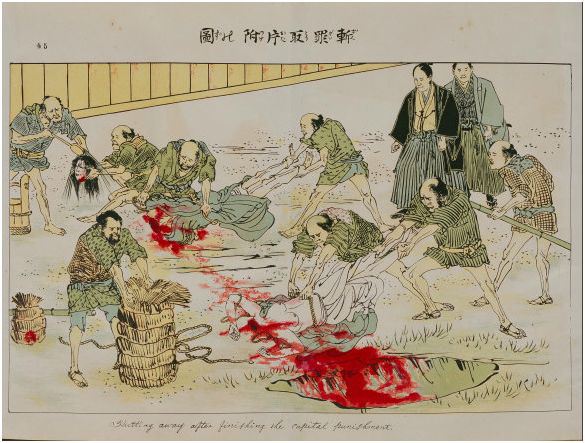

Follow @gaijinass
We’ve talked about other haunted Japanese hot spots in the past but I came across an excellent breakdown of the 3 great execution grounds of Tokyo over at the Japan This blog.
Japan has a long history of capital punishment and thousands of people were put to death usually by beheading but they were also big proponents of death by fire and crucifixions. According to the Japan This blog the areas where the executions took place are now cheap to live because they are associated with the angry spirits of those that were killed there.
Of course Tokyo is a giant graveyard as hundreds of thousands were killed all over the city during the great American bombing campaigns of World War II. In just one night, March 9 1945, incendiary bombs caused multiple fires that killed over 100,000 people. That’s more dead than either of the two nuclear strikes.
However the execution sites are concentrated places of death as well as former established living areas for Japan’s version of the untouchable class, so if it is cheap to live there that’s probably the reason. Japan This talks about three killing grounds in Tokyo:
|
They go into great detail about each place but they don’t talk at all about locations. So here is a break down:
Suzugamori
2-5-6 Minami-Oi Shinagawa-ku Tokyo (東京都品川区南大井2-5-6)

Suzugamori Execution Grounds are very close to Ōmori-Kaigan Station which is also the station you get off to go to the Shinagawa Aquarium, fun for the whole family! Voted one of the Top Hundred sites to see in Shinagawa, it is famous for people being burned at the stake. You can still see the stone post hole where the wooden stake, the victim was tied to, was placed before being set alight.


Kozukappara
The Kozukappara execution grounds are near Minami-Senju Station (南千住駅). Most of the killing grounds are now covered by the Minami-Senju rail yards but sandwiched in between two tracks is the 延命寺 Enmei-ji Temple. Next to the Enmei-ji Temple is the 首切地蔵 Kubikiri Jizō, a Buddha statue that criminals were knelt in front of just before they were killed. For thousands it would have been the last thing they saw.



Denma-chō
Denma-cho execution grounds are located close to Kodemmachō Station (小伝馬町駅). Denma-cho Prison was a famous prison and execution site for the upper classes of Tokyo.
Shut down by the Meiji Government in 1871 … little remains of the site today, but the few bits and pieces that are still extant can be seen at 大安楽寺 Daianraku-ji Daianraku Temple and 十思公園 Jisshi Kōen Jisshi Park. The actual site encompassed those locations as well 十思小学校 Jisshi Shōgakkō Jisshi Elementary School.


Of course Japan still has the death penalty and ever since the end of the war they execute their death row inmates by hanging. The last time a death sentence was carried was on December 12, 2013.
Japan does not tell death row prisoners that they are to be hanged until the last possible minute. This has been condemned by the international community. The failure to give advanced notice of executions is incompatible with articles 2, 7 and 10 of the International Covenant on Civil and Human Rights, according to the United Nations Human Rights Committee … Amnesty International says the inmates live under “a harsh regime and in solitary confinement with the ever-present fear of execution. They never know if each day will be their last.” — BBC News
Read more Nonsense from GaijinAss by Checking out:
 |
 |
 |
 |
 |
| 7 reasons not go to the clink in Japan | 7 Books for Warriors | Enlisting | The American Occupation of Okinawa | Death Row Survivor |




I am currently reading the manga “Samurai Executioner” by Kazuo Koike and Goseki Kojima. On volume four. The pictures that you included in this post are akin to the scenes in the manga. Therefore, I was glued to this post.
Bonus I have a new Japan blog bookmarked now “Japan This”. That makes this post really nice. Glad I checked it out.
Wonder if many people go checking out these spots for their history? Any good urban legends or stories of hauntings? Keep up the good work Yos.
I went to the Buddha statue place to get the pictures. It is supposedly in the “worst” part of Tokyo, San’ya, but it looked fine to me.
What is rumored to go on there to give it that reputation?
Under Japan’s old caste system there used to be a group of untouchable people called the burakumin. San’ya was where they lived.
— Sanya: A travel guide to Tokyo’s coolest ghetto
My current job makes me feel like I am less than human. A lot less. This makes me feel like San’ya, with its untouchable caste history, might be a good place for me. Although if it is full of non-Asian foreigners I wouldn’t be able to find a good game of mahjong, warm sake, or hot tea and thus would hate it.